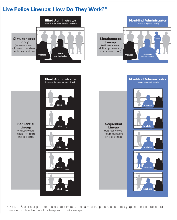Eyewitness Identification: Simultaneous vs. Sequential Lineups
Most U.S. law enforcement agencies use the simultaneous lineup, in which the eyewitness views a lineup of individuals or a photo array; that is, all individuals are viewed at the same time. However, some research has indicated that a sequential lineup, in which photographs are presented to the witness one at a time, produces fewer false identifications as well as fewer true identifications [1, 2].
The two types of lineups require different mental processes from the witness:
-
For sequential lineups, witnesses must exercise "absolute judgment," comparing each photograph or person only to their memory of what the offender looked like.
-
In simultaneous lineups, witnesses must use "relative judgment" to compare lineup photographs or members to each other.
Which Lineup Is Better?
So far, research that compares simultaneous and sequential lineups and the use of "blind" administrators has not been conclusive. In a blind lineup, the person who is running the lineup does not know which person the police believe is the likely suspect.
In 2006, an Illinois law enforcement project conducted a field experiment that compared double-blind sequential identification with simultaneous eyewitness identification. They found a higher rate of correct identifications in simultaneous nonblind lineups and a higher rate of false identifications in sequential double-blind lineups.
Read the study's complete report (pdf, 76 pages), appendices (pdf, 256 page) and addenda (pdf, 13 pages) Exit Notice.
However, questions have been raised about the methodology used in the study.
A 2003 study of a new photographic double-blind sequential lineup protocol used by some police departments in Hennepin County, Minn., also produced conflicting results. [3]
Works Cited
[1] Carlson, C. A., Gronlund, S. D., and Clark, S. E. (2008). “Lineup composition, suspect position, and the sequential lineup advantage” Journal of Experimental Psychology Applied, 14, 118-128.
[2] Haw, R.M. and Fisher, R.P. (2004) “Effects of Administrator-Witness Contact on Eyewitness Identification Accuracy,” Journal of Applied Psychology, 89 (6). 1106–1112.
[3] Klobuchar, A., N. Steblay, and H.L. Caligiuri (2006), "Improving Eyewitness Identifications: Hennepin County's Blind Sequential Lineup Pilot Project," Cardozo Public Law, Policy, and Ethics Journal



